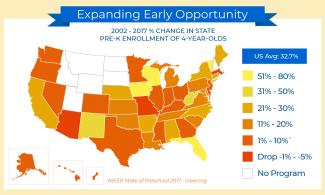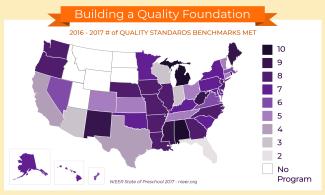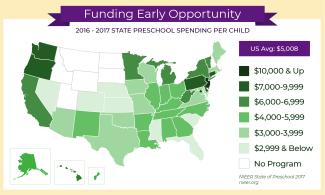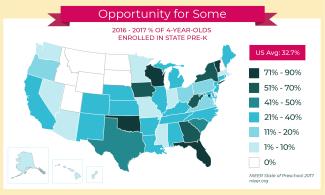
The State of Preschool Yearbook 2017
Summary


The State of Preschool 2017 annual report, based on 2016-17 academic year data, finds states heeding the demand for pre-K and expanding access to publicly funded programs in a variety of settings. But instead of supporting quality early learning with adequate resources, most state programs invest too little to help children catch up with their more advantaged peers by kindergarten.
“Recent changes in federal policy–including the Every Student Succeeds Act (ESSA)–make it clear that progress in early education depends more than ever on the states,” said NIEER Senior Co-Director Steven Barnett. “Our report highlights which states invest best in their young children and which leave too many children behind.”
The NIEER State of Preschool yearbook is the only national report on state-funded preschool programs. This year’s report includes a special section on policies affecting Dual Language Learners (DLLs), and also highlights changes since 2002, when NIEER began tracking state pre-K.
Nationwide, state-funded preschool program enrollment exceeded 1.5 million children, 33 percent of 4-year-olds and 5 percent of 3-year-olds. State funding for preschool rose two percent to about $7.6 billion, an almost $155 million increase (adjusted for inflation), since 2015-2016. State funding per child was $5,008, a slight decline from 2015-16 adjusted for inflation. Three state funded preschool programs met all 10 new quality standards benchmarks. Ten programs met fewer than half, and seven states do not invest any state dollars into preschool.
Profiles
-
Alabama
Alaska
Arizona
Arkansas
California
Colorado
Connecticut
Delaware
District of Columbia
Florida
Georgia
Hawaii
Idaho
Illinois
Indiana
Iowa
Kansas
Kentucky
Louisiana
Maine
Maryland
Massachusetts
Michigan
Minnesota
Mississippi
Missouri
Montana
Nebraska
Nevada
New Hampshire
New Jersey
New Mexico
New York
North Carolina
North Dakota
Ohio
Oklahoma
Oregon
Pennsylvania
Rhode Island
South Carolina
South Dakota
Tennessee
Texas
Utah
Vermont
Virginia
Washington
West Virginia
Wisconsin
Wyoming
Suggested Citation
Friedman-Krauss, A. H., Barnett, W. S., Weisenfeld, G. G., Kasmin, R., DiCrecchio, N., & Horowitz, M. (2018). The State of Preschool 2017: State Preschool Yearbook. New Brunswick, NJ: National Institute for Early Education Research.



